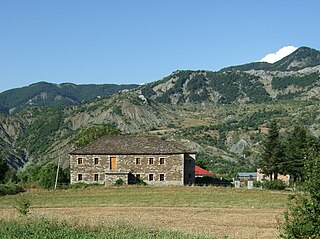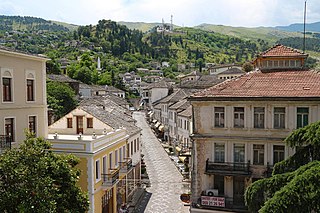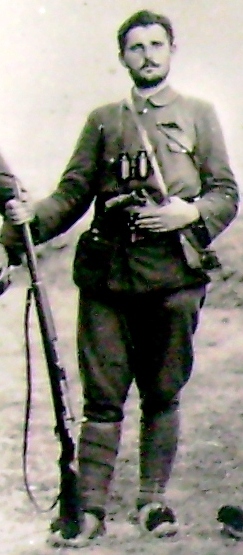
Korçë is the eighth most populous city of Albania and the seat of Korçë County and Korçë Municipality. The total population of the city is 51,152 and 75,994 of Korçë municipality, in a total area of 806 km2 (311 sq mi). It stands on a plateau some 850 m (2,789 ft) above sea level, surrounded by the Morava Mountains.

Gjirokastër County is one of the 12 counties of Albania. The total population in 2023 was 60,013, in an area of 2884 km2. Its capital is the city Gjirokastër.

Himarë is a municipality and region in Vlorë County, southern Albania. The municipality has a total area of 571.94 km2 (220.83 sq mi) and consists of the administrative units of Himarë, Horë-Vranisht and Lukovë. It lies between the Ceraunian Mountains and the Albanian Ionian Sea Coast and is part of the Albanian Riviera. The traditionally perceived borders of the Himarë region gradually shrank during the Ottoman period, being reduced to the town of Himarë and the villages of the coastline, generally including only Palasë, Dhërmi, Pilur, Kudhës, Vuno, Iljas and Qeparo.

Delvinë is a town and a municipality in Vlorë County, southern Albania, 16 kilometres northeast of Sarandë. It was formed in the 2015 local government reform by the merger of the former municipalities Delvinë and Vergo, which became municipal units. The seat of the municipality is the town Delvinë. The population of the municipal unit Delvinë at the 2023 census was 4,952 and of the municipality was 6,166.

Filiates is a town and a municipality in Thesprotia, Greece. It is located in the northernmost part of the regional unit, bordering western Ioannina regional unit and southern Albania.

Finiq is a settlement, considered a town or village, and municipality in Vlorë County, in southern Albania located 8 km from the Ionian Sea and 20 km north of the Greek border. It was formed at the 2015 local government reform by the merger of the former communes Aliko, Dhivër, Livadhja, Mesopotam, and Finiq itself. It is inhabited by ethnic Greeks and is one of two municipalities in Albania in which Greeks form a majority, alongside Dropull. The seat of the municipality is the village Dërmish. The total population is 10,529, in a total area of 444.28 km2.
Lunxhëri is a region in the Gjirokastër County, Albania. It is an ethnographic region along with neighboring regions such as Kurvelesh, Zagoria, Dropull. It is in the periphery of a wider ethnographic region known as Labëria, though its population is said to be non-Lab. Many of its native inhabitants prefer for Lunxhëria to be identified instead as Tosk, as are neighboring regions to the east such as Dangëllia and Kolonja, rather than Lab; some researchers instead prefer to view Lunxhëria as a "transitory region" that is linguistically part of Labëria but culturally part of Toskëria. Lunxhëria is predominantly inhabited by Albanians, but also has Greek and Aromanian minorities.
Zagoria is a former municipality in the Gjirokastër County, southern Albania. During the 2015 local government reform, Zagoria became a subdivision of the municipality Libohovë. The population at the 2011 census was 411. Since 2018, the region has been at the centre of the expanded Zagoria Nature Park. Zagoria is also considered to be a distinct "ethnographic region", traditionally consisting of ten settlements: Sheper, Nivan, Ndëran, Topovë, Konckë, Hoshteve, Lliar, Vithuq, Doshnicë and Zhej.

Frashër is a village and a former municipality in the Gjirokastër County, southern Albania. At the 2015 local government reform it became a subdivision of the municipality Përmet. The population at the 2011 census was 387. The municipal unit consists of the villages Frashër, Zavalan, Ogren-Kostrec, Gostivisht, Miçan, Vërçisht, Kreshovë and Soropull.
Himariote Greek is a dialect of the Greek language that is mainly spoken by ethnic Greeks in the Himara region of Albania. Despite the small distances between the settlements in the region, there exists some dialectal variation, most prominently in accent.

Panteleimon of Gjirokastër was a bishop of the Orthodox Autocephalous Church of Albania. He was the metropolitan bishop of Gjirokastër (1937–1941) and later the President of the exiled Northern Epirus resistance faction KEVA after the end of World War II.

Fehim bey Zavalani (1859-1935) was an Albanian landowner from the Kolonjë area, journalist and activist of the Albanian National Awakening. He was also the editor of Bashkimi i Kombit, one of the most important Albanian newspapers of the era. In 1908 he became one of the head organizers of the Congress of Monastir, in which the Albanian alphabet was standardized.

Vuno is a village in the municipality of Himarë, Vlorë County, Albania. It is located on the road that connects the centre of Himarë with the village of Dhërmi on the Albanian Riviera. The population of Vuno is exclusively Orthodox Albanian.
Vurg is a plain and region in the southern part of Vlorë County, southwestern Albania.
Labovë e Kryqit is a settlement in Southern Albania, which has taken the name of its famous church, the Dormition of the Theotokos Church. It consists of two neighbourhoods: Labovë e Poshtme and Labovë e Sipërme. To distinguish it from its neighbour Labovë e Madhe, the village is known by two names Labovë e Kryqit, in reference to a nearby old Byzantine church and Labovë e Libohovës. It is part of the Qendër Libohovë subdivision of the Libohovë municipality, in Gjirokastër County, southern Albania.

Princess Argjiro or Argyro is a legendary figure in Albanian. She is supposed to have lived in the 15th century.

Gjirokastër is a city in southern Albania and the seat of Gjirokastër County and Gjirokastër Municipality. It is located in a valley between the Gjerë mountains and the Drino, at 300 metres above sea level. Its old town is a UNESCO World Heritage Site. The city is overlooked by Gjirokastër Fortress, where the Gjirokastër National Folk Festival is held every five years. It is the birthplace of former Albanian communist leader Enver Hoxha, and author Ismail Kadare.
The Second Congress of Manastir was an Albanian congress held on 2–3 April 1910 in Manastir, back then Ottoman Empire, today's Bitola in the Republic of North Macedonia. It dealt with the challenges that the Albanian language and schools faced at the time within the context of the empire, and the platform to overcome them.

Menduh Zavalani (1889–1914) was an Albanian revolutionary and political leader active during the last years of the Albanian National Awakening. He formed his own revolutionary band and was one of the leaders that liberated Përmet and the environs from the Ottoman Empire. Menduh was an appointed delegate from his hometown Korça to the Albanian National Congress that proclaimed the Independence of Albania. In the intellectual level Menduh was noted for the translation of Friedrich Schiller's drama Wilhelm Tell into Albanian. He was assassinated at a very young age near Pogradec by a local collaborationist band.
This article is about demographic history of Gjirokastër County, which includes the municipalities of Gjirokastër, Këlcyrë, Libohovë, Memaliaj, Përmet, Tepelenë, and Dropull.






















